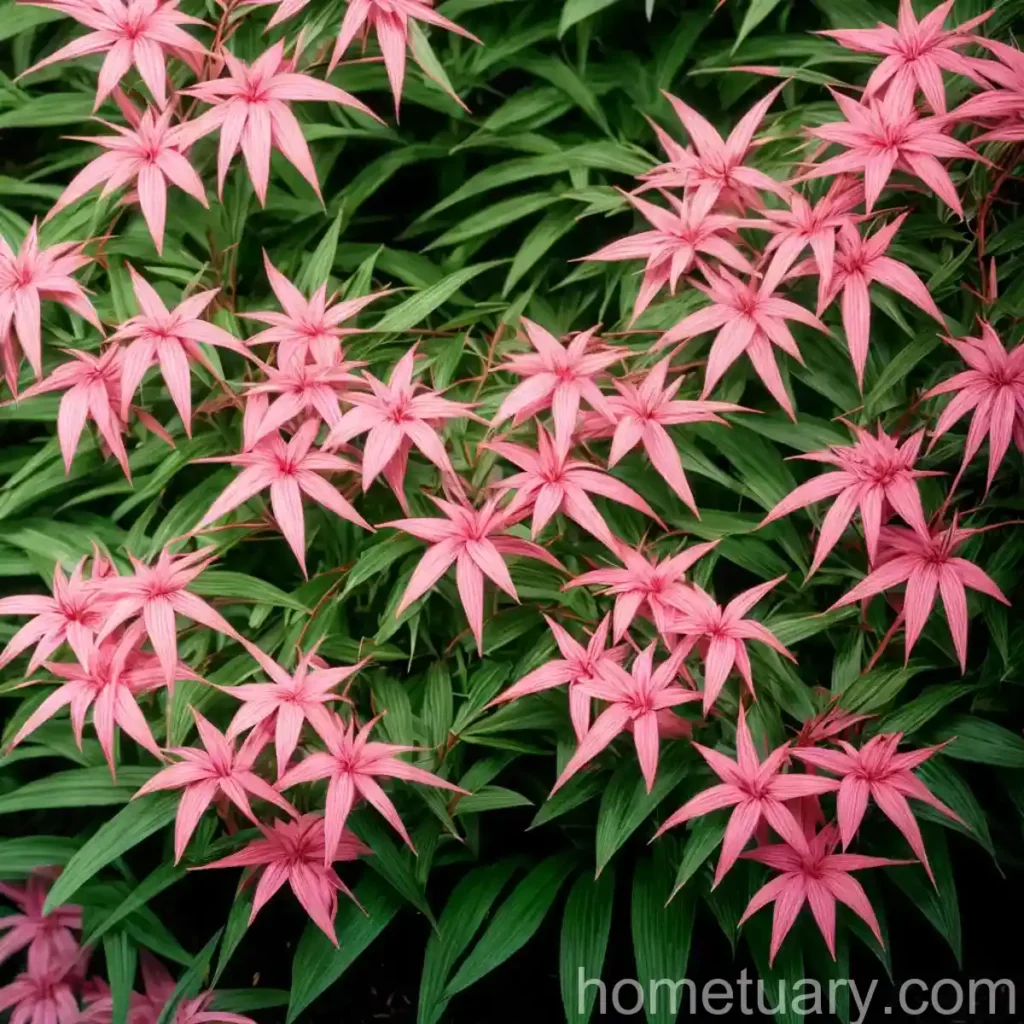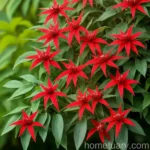Plant Profile: Heavenly Bamboo (Nandina domestica ‘Aka’ BLUSH PINK)
Heavenly bamboo, scientifically known as Nandina domestica, is a versatile and visually appealing plant that belongs to the Berberidaceae family. It is commonly known for its graceful, bamboo-like leaves, and vibrant red berries. The ‘Aka’ BLUSH PINK variety of Nandina domestica is a particularly stunning cultivar with unique bright pink foliage that adds a burst of color to any landscape. In this comprehensive guide, we will explore the culture, uses, care requirements, and interesting facts about the heavenly bamboo (Nandina domestica ‘Aka’ BLUSH PINK) plant.
Key Takeaways – Heavenly Bamboo (Nandina domestica ‘Aka’ BLUSH PINK)
- Nandina domestica ‘Aka’ BLUSH PINK is a striking evergreen shrub with vibrant pink foliage.
- It is prized for its ornamental value and is ideal for adding color and texture to garden landscapes.
- This variety is relatively low-maintenance and can thrive in various growing conditions, making it an excellent choice for both experienced and novice gardeners.
Now, let’s delve into the detailed aspects of this captivating plant, including its culture, uses, care requirements, and maintenance tips.
What is “Heavenly Bamboo” (Nandina domestica ‘Aka’ BLUSH PINK)?
Description and Characteristics
Heavenly Bamboo (Nandina domestica ‘Aka’ BLUSH PINK) is a compact, evergreen shrub with an upright and bamboo-like growth habit, featuring vibrant, lance-shaped leaves that emerge in shades of pink and mature into a deep green color with a red blush. This cultivar is especially prized for its stunning display of pink foliage, which intensifies in color during the cooler months, adding a vibrant touch to winter landscapes.
Flowering and Berries
In addition to its colorful foliage, heavenly bamboo produces delicate, star-shaped white flowers in the spring, which give way to clusters of bright red berries in the fall and winter. The berries persist throughout the colder seasons, creating a captivating contrast against the foliage and attracting birds to the garden.
Growth Habit and Size
The ‘Aka’ BLUSH PINK variety typically reaches a height of 2 to 4 feet and spreads about 2 to 3 feet wide, making it an excellent choice for border plantings, mass plantings, or container gardening. Its compact size and attractive foliage make it well-suited for both residential and commercial landscapes.
Culture
Uses
The heavenly bamboo (Nandina domestica ‘Aka’ BLUSH PINK) plant offers a multitude of practical and aesthetic uses in landscape design and gardening. Some of its primary uses include:
- Ornamental Purposes: Its vibrant pink foliage and subsequent red berries make it an eye-catching addition to garden beds, borders, and containers.
- Privacy Screen: When planted in groups or clusters, heavenly bamboo can serve as a natural, low-maintenance privacy screen or hedge due to its dense growth habit.
- Erosion Control: Its fibrous root system and dense foliage help to stabilize soil and prevent erosion, making it a valuable addition to slopes and embankments.
- Wildlife Attraction: The berries of Nandina domestica ‘Aka’ BLUSH PINK provide a food source for birds, making it a wildlife-friendly plant for bird enthusiasts.
Water
Heavenly bamboo is known for its moderate water needs, and while it is relatively drought-tolerant once established, it benefits from regular watering, especially during periods of prolonged dryness. When grown in containers, it’s essential to monitor the moisture levels and ensure adequate drainage to prevent waterlogged soil.
Sunlight
For optimal growth and vibrant foliage coloration, heavenly bamboo thrives in part to full sun locations, receiving at least 6 to 8 hours of direct sunlight daily. However, it can also tolerate partial shade, particularly in hot climates, as long as it still receives adequate light to support healthy growth.
Fertilizer
When it comes to fertilization, heavenly bamboo (Nandina domestica ‘Aka’ BLUSH PINK) benefits from a balanced, slow-release fertilizer formulated for acid-loving plants. Applying a fertilizer with a relatively equal ratio of nitrogen, phosphorus, and potassium once in early spring can help promote healthy foliage and berry production without excessive vegetative growth.
Soil
This cultivar thrives in well-draining, slightly acidic soil with a pH range between 5.0 and 6.5. It adapts well to a wide range of soil types, including loamy, sandy, or clay soils, as long as proper drainage is maintained. Amending the soil with organic matter, such as compost or peat moss, can enhance its overall fertility and structure.
Pruning
Regular pruning is essential for maintaining the shape, density, and overall health of heavenly bamboo (Nandina domestica ‘Aka’ BLUSH PINK). Pruning can be done selectively to remove dead, damaged, or weak branches and to shape the plant to the desired form. It’s crucial to avoid heavy pruning in late summer and fall, as this can stimulate new growth that may not have sufficient time to harden before the arrival of frost or colder weather.
Propagation
Heavenly bamboo can be propagated through several methods, including:
- Division: Established clumps can be divided by carefully digging up the plant and separating the clumps into smaller sections, each with a portion of the root system and shoots.
- Softwood Cuttings: Softwood cuttings taken in the spring can be rooted in a suitable growing medium, such as a mix of peat and perlite, to produce new plants.
- Seed Propagation: While viable seeds are produced by the plant, germination can be erratic, and propagation from seeds may not yield offspring that are true to the parent plant’s characteristics.
Container Popularity
The compact size and attractive foliage of the ‘Aka’ BLUSH PINK variety make it exceptionally popular for container gardening. When grown in containers, it can be used to adorn patios, decks, or outdoor living spaces, adding a pop of color and texture to the surroundings. The versatility of container-grown heavenly bamboo allows it to be easily moved to different locations and provides an excellent option for gardeners with limited planting space or those who wish to create portable decorative accents.
Common Diseases
Heavenly bamboo (Nandina domestica ‘Aka’ BLUSH PINK) may be susceptible to certain diseases, including:
- Leaf Spot: Fungal diseases such as Cercospora and Phyllosticta can cause unsightly leaf spots, leading to leaf discoloration and premature defoliation if left untreated.
- Powdery Mildew: This common fungal infection can appear as a whitish, powdery growth on the leaves and stems, hindering photosynthesis and weakening the overall vigor of the plant.
- Fire Blight: While less common, fire blight, caused by the bacterium Erwinia amylovora, can affect the foliage and stem tissue, leading to wilting, necrosis, and dieback.
Disease Diagnosis
When inspecting heavenly bamboo for signs of disease, it’s essential to look for characteristic symptoms such as leaf spots, powdery coatings, wilting, and abnormal growth patterns. Proper diagnosis often involves identifying the specific symptoms and, if necessary, consulting with a plant health specialist or extension service for accurate disease identification and management recommendations.
Common Pests
While generally pest-resistant, heavenly bamboo (Nandina domestica ‘Aka’ BLUSH PINK) may occasionally encounter pests such as:
- Aphids: These tiny, sap-sucking insects can infest the new growth of the plant and may excrete honeydew, leading to the development of sooty mold.
- Scale Insects: Scale insects can attach themselves to the stems and leaves of the plant, feeding on the plant sap and causing yellowing of the foliage and stunted growth.
- Spider Mites: Spider mites are small arachnids that can be problematic in hot, dry conditions, causing stippling, discoloration, and webbing on the leaves.
Botanist’s Tips
- Regularly monitor the plant for any signs of disease, pests, or nutrient deficiencies, and address any issues promptly to prevent them from spreading to adjacent plants.
- When selecting a planting location, consider the mature size of the plant to ensure adequate space for its growth and allow for proper air circulation.
Fun Facts
- The berries of heavenly bamboo are not edible for humans and can be toxic if ingested, making them unpalatable for culinary use.
- While it is commonly referred to as “heavenly bamboo,” Nandina domestica is not a true bamboo and is not related to the grass family (Poaceae).
Links to External Resources
For additional information on heavenly bamboo (Nandina domestica ‘Aka’ BLUSH PINK), refer to the following resources:
- The Spruce – Tips for Growing Nandina Plants
- Mississippi State University Extension – Heavenly Bamboo in the Landscape
- University of Florida IFAS Extension – Nandina domestica: Heavenly Bamboo
In conclusion, Nandina domestica ‘Aka’ BLUSH PINK, or heavenly bamboo, is a captivating and versatile plant with its vibrant pink foliage, attractive growth habit, and ornamental berries. Its adaptability to various growing conditions, low-maintenance requirements, and multiple landscape uses make it an excellent choice for adding visual interest to gardens, landscapes, and outdoor spaces. By understanding its cultural needs, disease and pest management, and propagation methods, gardeners can confidently incorporate this stunning cultivar into their horticultural endeavors, enhancing the beauty and biodiversity of their surroundings.
With its evergreen presence, striking coloration, and diverse applications, heavenly bamboo (Nandina domestica ‘Aka’ BLUSH PINK) continues to be a popular and cherished addition to gardens and landscapes, exemplifying the enduring allure of ornamental plants in the horticultural world.















